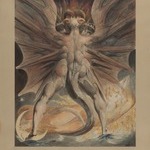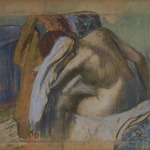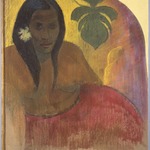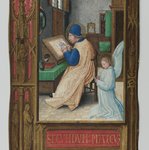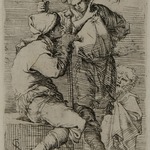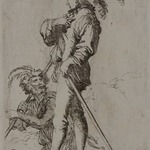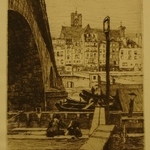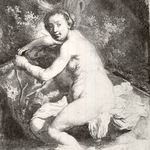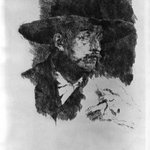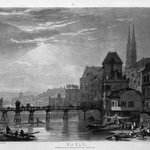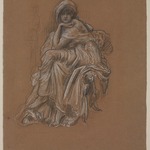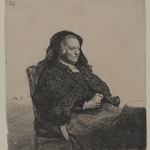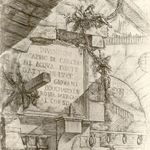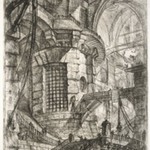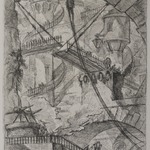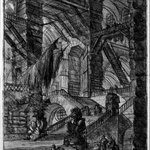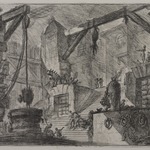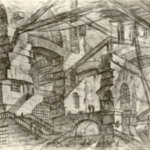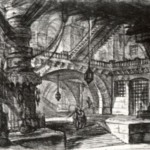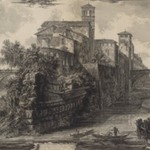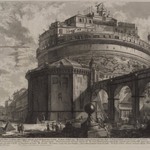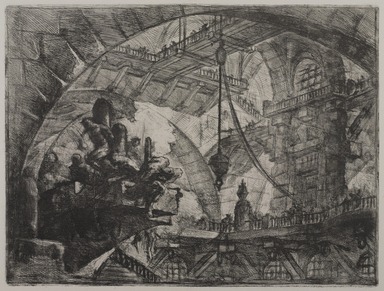
Invenzioni Capric di Carceri; Hind 10, First State of Three
Giovanni Battista Piranesi
European Art
Around 1749–50 Giovanni Battista Piranesi published an ambitious series of fourteen large etchings known as The Imaginary Prisons. These plates depict vast, labyrinthine spaces spanned by vaults and arches, crossed by seemingly endless staircases, and filled with hooks, chains, and ropes that suggest machines of torture. The enormous chambers dwarf the mysterious figures that populate them, evoking an oppressive and unrelenting atmosphere of privation and despair.
Piranesi was trained as an architect, and the design of his fantastical dungeons was informed by his knowledge of ancient Roman ruins. Classical architecture was a symbol of Western civilization and its achievements, but here, it represents something dark and irrational. The human agency so valued by Enlightenment principles appears crushed within an impersonal and ominous universe.
Piranesi’s experience with theatrical set design was likely another source of inspiration for him. In turn, echoes of his prisons’ limitless, confusing spaces can be found in productions up to the present day, including the movies Metropolis, Blade Runner, and Inception, as well as the moving staircase of Hogwarts in the Harry Potter films.
The plates for the rarer first edition—seen here—were only lightly etched by Piranesi, allowing the freedom and spontaneity of his drawing to emerge.
Titus Kaphar: The. . . thing that’s interesting to me about these . . . thinking about our own prison industrial complex, is these spaces are way too small. For the number of individuals that we have in prison today, this would be insufficient. . . . The other thing is they are architectural. There’s an expression of value in the aesthetics of the prison itself. We don’t do that. We built them big. We built them fast. We built them simple. . . .
The other thing that is interesting about these spaces is their almost grand exterior foyers. . . . You see these staircases that bring people in. . . .There are folks who are going to come and visit these prisoners. . . . This is completely antithetical to anything that we consider in building today’s prisons, which is profound to me. Having been to many different prisons in the U.S., I can’t even imagine this as the same tool for caging people that we do. There’s such a drabness to what we provide. . . . This would feel architecturally uplifting to some degree. . . . They’re really beautiful, almost Gothic-looking spaces, some of these. . . . The only evidence I see. . . of the torture that takes place is these bodies underneath this arch on the left that feel as though maybe they are being punished right now. You see their muscles as they’re folded over into themselves. . . . [One figure looks] like she’s wielding some tool of torture. . . . Is there this idea, this passing idea, that at some point we realized that this institution, this structure, this way of dealing with the challenges of our society is not functional, and that it does come to ruin, ultimately?
Piranesi was trained as an architect, and the design of his fantastical dungeons was informed by his knowledge of ancient Roman ruins. Classical architecture was a symbol of Western civilization and its achievements, but here, it represents something dark and irrational. The human agency so valued by Enlightenment principles appears crushed within an impersonal and ominous universe.
Piranesi’s experience with theatrical set design was likely another source of inspiration for him. In turn, echoes of his prisons’ limitless, confusing spaces can be found in productions up to the present day, including the movies Metropolis, Blade Runner, and Inception, as well as the moving staircase of Hogwarts in the Harry Potter films.
The plates for the rarer first edition—seen here—were only lightly etched by Piranesi, allowing the freedom and spontaneity of his drawing to emerge.
Titus Kaphar: The. . . thing that’s interesting to me about these . . . thinking about our own prison industrial complex, is these spaces are way too small. For the number of individuals that we have in prison today, this would be insufficient. . . . The other thing is they are architectural. There’s an expression of value in the aesthetics of the prison itself. We don’t do that. We built them big. We built them fast. We built them simple. . . .
The other thing that is interesting about these spaces is their almost grand exterior foyers. . . . You see these staircases that bring people in. . . .There are folks who are going to come and visit these prisoners. . . . This is completely antithetical to anything that we consider in building today’s prisons, which is profound to me. Having been to many different prisons in the U.S., I can’t even imagine this as the same tool for caging people that we do. There’s such a drabness to what we provide. . . . This would feel architecturally uplifting to some degree. . . . They’re really beautiful, almost Gothic-looking spaces, some of these. . . . The only evidence I see. . . of the torture that takes place is these bodies underneath this arch on the left that feel as though maybe they are being punished right now. You see their muscles as they’re folded over into themselves. . . . [One figure looks] like she’s wielding some tool of torture. . . . Is there this idea, this passing idea, that at some point we realized that this institution, this structure, this way of dealing with the challenges of our society is not functional, and that it does come to ruin, ultimately?
MEDIUM
Etching on laid paper
DATES
ca. 1749
DIMENSIONS
16 1/4 x 21 5/16 in. (41.2 x 54.2 cm) (show scale)



COLLECTIONS
European Art
ACCESSION NUMBER
37.356.8
CREDIT LINE
Frank L. Babbott Fund and Carll H. de Silver Fund
MUSEUM LOCATION
This item is not on view
CAPTION
Giovanni Battista Piranesi (Italian, Venetian, 1720–1778). Invenzioni Capric di Carceri; Hind 10, First State of Three, ca. 1749. Etching on laid paper, 16 1/4 x 21 5/16 in. (41.2 x 54.2 cm). Brooklyn Museum, Frank L. Babbott Fund and Carll H. de Silver Fund, 37.356.8 (Photo: , 37.356.8_PS9.jpg)
IMAGE
overall, 37.356.8_PS9.jpg., 2019
"CUR" at the beginning of an image file name means that the image was created by a curatorial staff member. These study images may be digital point-and-shoot photographs, when we don\'t yet have high-quality studio photography, or they may be scans of older negatives, slides, or photographic prints, providing historical documentation of the object.
RIGHTS STATEMENT
No known copyright restrictions
This work may be in the public domain in the United States. Works created by United States and non-United States nationals published prior to 1923 are in the public domain, subject to the terms of any applicable treaty or agreement.
You may download and use Brooklyn Museum images of this work. Please include caption information from this page and credit the Brooklyn Museum. If you need a high resolution file, please fill out our online application form (charges apply).
The Museum does not warrant that the use of this work will not infringe on the rights of third parties, such as artists or artists' heirs holding the rights to the work. It is your responsibility to determine and satisfy copyright or other use restrictions before copying, transmitting, or making other use of protected items beyond that allowed by "fair use," as such term is understood under the United States Copyright Act.
The Brooklyn Museum makes no representations or warranties with respect to the application or terms of any international agreement governing copyright protection in the United States for works created by foreign nationals.
For further information about copyright, we recommend resources at the United States Library of Congress, Cornell University, Copyright and Cultural Institutions: Guidelines for U.S. Libraries, Archives, and Museums, and Copyright Watch.
For more information about the Museum's rights project, including how rights types are assigned, please see our blog posts on copyright.
If you have any information regarding this work and rights to it, please contact copyright@brooklynmuseum.org.
RECORD COMPLETENESS
Not every record you will find here is complete. More information is available for some works than for others, and some entries have been updated more recently. Records are frequently reviewed and revised, and we welcome any additional information you might have.

